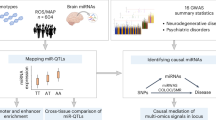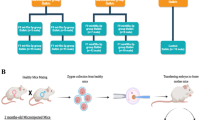Abstract
MiRNAs are small noncoding RNAs that control the expression of target genes at the post-transcriptional level and have been reported to modulate various biological processes. Their function as regulatory factors in gene expression renders them attractive candidates for harbouring genetic variants with subtle effects on IQ. In an attempt to investigate the potential role of miRNAs in the aetiology of X-linked mental retardation, we have examined all 13 known, brain-expressed X-chromosomal miRNAs in a cohort of 464 patients with non-syndromic X-linked MR and found four nucleotide changes in three different pre-miRNA hairpins. All the observed changes appear to be functionally neutral which, taken together with the rarity of detected nucleotide changes in miRNA genes, may reflect strong selection and thus underline the functional importance of miRNAs.
Similar content being viewed by others
Log in or create a free account to read this content
Gain free access to this article, as well as selected content from this journal and more on nature.com
or
References
Reinhart BJ, Slack FJ, Basson M et al: The 21-nucleotide let-7 RNA regulates developmental timing in Caenorhabditis elegans. Nature 2000; 403: 901–906.
Brennecke J, Hipfner DR, Stark A, Russell RB, Cohen SM : Bantam encodes a developmentally regulated microRNA that controls cell proliferation and regulates the proapoptotic gene hid in Drosophila. Cell 2003; 113: 25–36.
Chen CZ, Li L, Lodish HF, Bartel DP : MicroRNAs modulate hematopoietic lineage differentiation. Science 2004; 303: 83–86.
Poy MN, Eliasson L, Krutzfeldt J et al: A pancreatic islet-specific microRNA regulates insulin secretion. Nature 2004; 432: 226–230.
Giraldez AJ, Cinalli RM, Glasner ME et al: MicroRNAs regulate brain morphogenesis in zebrafish. Science 2005; 308: 833–838.
Stevenson RE, Schwarte CE, Schroer RJ : X-linked Mental Retardation. Oxford: Oxford University Press, 2000.
Ropers HH, Hamel BC : X-linked mental retardation. Nat Rev Genet 2005; 6: 46–57.
Fishburn J, Turner G, Daniel A, Brookwell R : The diagnosis and frequency of X-linked conditions in a cohort of moderately retarded males with affected brothers. Am J Med Genet 1983; 14: 713–724.
Biancalana V, Beldjord C, Taillandier A et al: Five years of molecular diagnosis of Fragile X syndrome (1997–2001): a collaborative study reporting 95% of the activity in France. Am J Med Genet A 2004; 129: 218–224.
Gronskov K, Hjalgrim H, Nielsen IM, Brondum-Nielsen K : Screening of the ARX gene in 682 retarded males. Eur J Hum Genet 2004; 12: 701–705.
Mandel JL, Chelly J : Monogenic X-linked mental retardation: is it as frequent as currently estimated? The paradox of the ARX (Aristaless X) mutations. Eur J Hum Genet 2004; 12: 689–693.
Leonard H, Wen X : The epidemiology of mental retardation: challenges and opportunities in the new millennium. Ment Retard Dev Disabil Res Rev 2002; 8: 117–134.
Bartel DP : MicroRNAs: genomics, biogenesis, mechanism, and function. Cell 2004; 116: 281–297.
Bentwich I, Avniel A, Karov Y et al: Identification of hundreds of conserved and nonconserved human microRNAs. Nat Genet 2005; 37: 766–770.
Jensen LR, Lenzner S, Moser B et al: X-linked mental retardation: a comprehensive molecular screen of 47 candidate genes from a 7.4 Mb interval in Xp11. Eur J Hum Genet, advance online publication, 13 September 2006.
Lee Y, Jeon K, Lee JT, Kim S, Kim VN : MicroRNA maturation: stepwise processing and subcellular localization. EMBO J 2002; 21: 4663–4670.
Han J, Lee Y, Yeom KH et al: Molecular basis for the recognition of primary microRNAs by the Drosha–DGCR8 complex. Cell 2006; 125: 887–901.
Acknowledgements
We are grateful to Dr Robledo and Dr Siniscalco for providing patient material of family MRX26, and to M Amende and B Lipkowitz for excellent technical support. The study was supported by the EURO-MRX project, part of the European ‘Quality of Life and Management of Living Resources Programme’ QLG3-CT-2002-01810, and by the Collaborative Research Program (SFB) 577 of the Deutsche Forschungsgemeinschaft.
Author information
Authors and Affiliations
Corresponding author
Rights and permissions
About this article
Cite this article
Chen, W., Jensen, L., Gecz, J. et al. Mutation screening of brain-expressed X-chromosomal miRNA genes in 464 patients with nonsyndromic X-linked mental retardation. Eur J Hum Genet 15, 375–378 (2007). https://doi.org/10.1038/sj.ejhg.5201758
Received:
Revised:
Accepted:
Published:
Issue date:
DOI: https://doi.org/10.1038/sj.ejhg.5201758
Keywords
This article is cited by
-
Etiology of intellectual disability in individuals from special education schools in the south of Brazil
BMC Pediatrics (2020)
-
Network Profiling of Brain-Expressed X-Chromosomal MicroRNA Genes Implicates Shared Key MicroRNAs in Intellectual Disability
Journal of Molecular Neuroscience (2019)
-
Mapping the landscape of tandem repeat variability by targeted long read single molecule sequencing in familial X-linked intellectual disability
BMC Medical Genomics (2018)
-
Intellectual disability associated with retinal dystrophy in the Xp11.3 deletion syndrome: ZNF674 on trial. Guilty or innocent?
European Journal of Human Genetics (2012)
-
MicroRNAs: A Light into the “Black Box” of Neuropediatric Diseases?
NeuroMolecular Medicine (2012)



